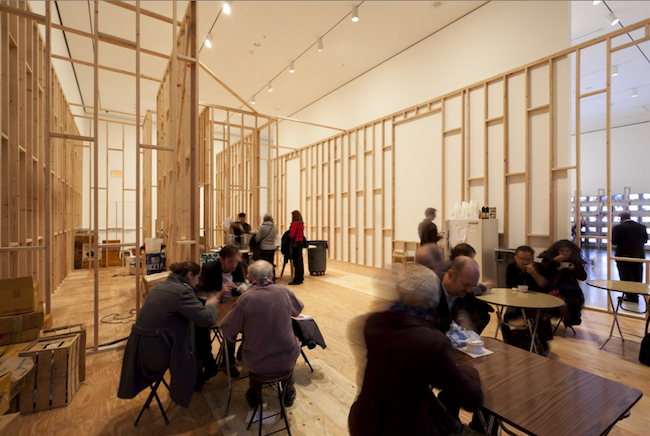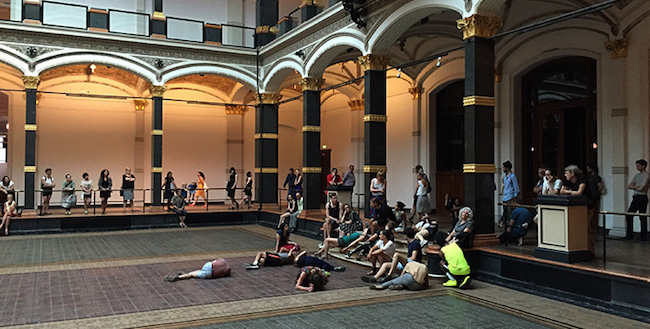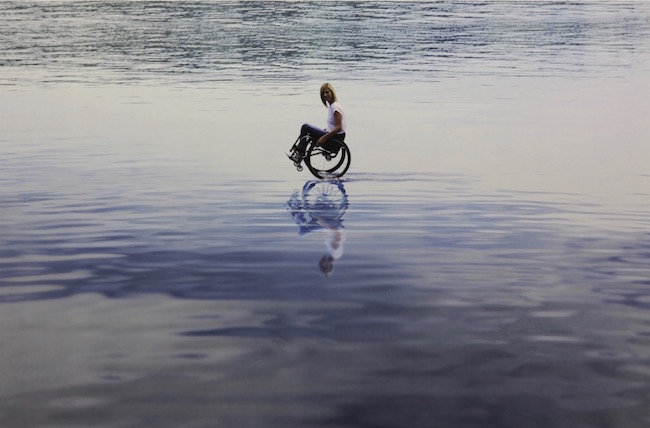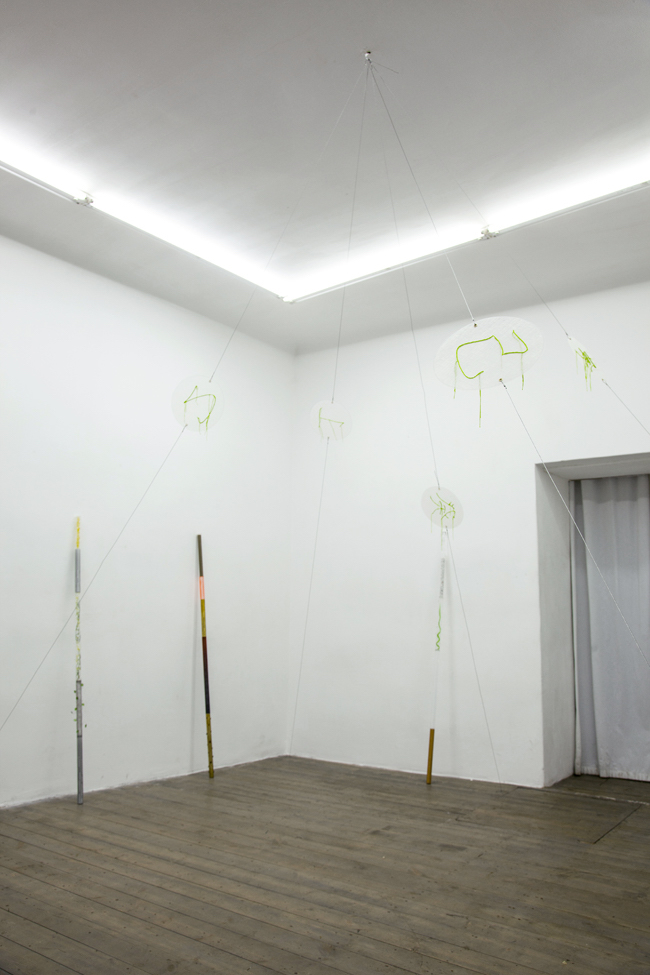
“artist-as-curator”
Estere Kajema
16/02/2017
Let us begin by thinking about who the curator is, what their responsibilities are, and what goals they might aim to achieve. Right now, in 2016, there is no singular definition of the word “curator” simply because of the amount of work that is constantly being created within the curatorial field. I suggest looking at the most traditional, and, in my mind, most effective role that a curator can fulfill - the role of a mediator. In his famous essay “Mediators”, the French philosopher Gilles Deleuze writes:
“Mediators are fundamental. Creation is all about mediators. Without them, nothing happens. They can be people - for a philosopher, artists or scientists; for a scientist, philosophers or artists - but things too, even plants or animals, as in Castaneda. Whether they are real or imaginary, animate or inanimate, you have to form your mediators.”[1]
Deleuze writes about something that Henri Bergson called “fabulation” - a moment of hallucinatory fiction, an image that is only capable of imitating the reality. Deleuze writes: “…To catch someone in the act of telling tales is to catch the movement of constitution of a people. A people isn’t something already there.”[2] It is clear for Deleuze that the truth is a concept that is produced - potentially, the role of a curator is to be a producer of truth, a creator of fables, but not from scratch. In the book Sharp Tongue, Loose Lips, Open Eyes, Ears to the Ground (2014), Hans Ulrich Obrist writes that the curator “is no longer understood as simply the person who fills a space with objects, but as the person who brings different cultural spheres into contact, invents new display features, and makes junctions that allow unexpected encounters and results.”[3]_ a curator is a figure that fills the different layers of an artist’s work that must be interpreted, and then glues them together in order to bring discipline and please the needs of both sides of the society of the spectacle.
In their text “The Middleman: Beginning to Talk About Mediation”, Søren Andreasen and Lars Bang Larsen decide to call the curator a “middleman”. They write:
“The figure of the middleman is typically seen as a conformist, parasitical agent responsible for short-circuiting authenticity. The middle-man has an aura of mediocrity. The middleman is average, and a suspect character. There is always the risk that he knows more than he should and that he feathers his own nest. In other words, the middleman has an opaque presence in social space.”[4]
The most important idea that a reader must grasp from this text is that the curator is not something – the curator does something.[5] The twenty-first century is full of overused and, sadly, misused words and concepts, and “curator” is one of them. Until a couple of years ago, art students did not have the option to choose modules on curation, there were no master’s degrees in curating, no specific textbooks or magazines edited by or for curators. You do not necessarily need to have a curating degree in order to call yourself a curator - contrary to, for instance, somebody who calls themselves a doctor, or a lawyer. You should have, though, a perfectly deep knowledge of art history, art theory, museology, and, most importantly, have an exceptionally good eye.
In theory, the idea of artists as curators might seem to be quite pretentious – at least to me, personally. But when it comes to real-life examples that most definitely shape contemporary art history, it is totally different. Some artists, such as Rirkrit Tiravanija, Tino Sehgal, Christian Jankowski, Keith Coventry, or even Andy Warhol, used curating as a medium with which to expand their practice.

Rirkrit Tiravanija. Untitled (free/still), 1992/1995/2007/2011-. MoMA. © 2017 Rirkrit Tiravanija
For example, in 1992, Rirkrit Tiravanija created an exhibition with the name Untitled (Free). During this exhibition, which took place at 303 Gallery in New York City, Tiravanija converted the gallery space into a kitchen in which he prepared and served rice and Thai curry for all gallery visitors. Even though this project is not an obviously curated project, it still must be considered as part of the artist’s curatorial practice. By turning the homogeneous white cube into a free kitchen, the artist created a space of Nicolas Bourriaud’s relational aesthetics, one in which the atmosphere and the visitors of the gallery became the artwork themselves. The artist made a decision to, metaphorically speaking, take the art off of the pedestal in order to make the visitors enjoy it from within. By making this decision, Tiravanija managed to re-perform and re-narrate the linear history of a white cube and the curatorial methods that it implies.

Tino Seghal. Exhibition at Martin Gropius Bay, 2015. Photo: berlin-kicks.com
Another example that comes straight to mind is Tino Sehgal’s 2015 exhibition at Martin-Gropius-Bau, in Berlin. During the exhibition that had no name, no catalog, no press release and no poster, Sehgal offered the spectator to join one of five so-called “situations” that were performed by a group of casted “interpreters”. When a spectator would join the situation called This Situation (2007), they would be suddenly surrounded by a group of people – six men and women – discussing different topics concerning contemporary culture. At times, This Situation might remind a spectator of a university seminar, or a start-up problem-solving meeting, or even a group therapy meeting. At some point, all six members of the group stop their conversation and say: “Welcome to this Situation,” out loud, all at the same time. Dorothea von Hantelmann, in her book How to Do Things with Art, writes:
“The choreography repeats, but with the dancers in reversed roles. This work [Kiss, 2002] is equally conceived as a loop, and it exists, executed by changing dancers, for the entire duration of the exhibition.” [6]
By making a decision to step outside his own work, Sehgal, according to von Hantelmann, is turning his work into a loop – the dancers (the performers) keep exchanging roles among themselves. This, indeed, stands against the traditional understanding of a curated exhibition – one in which the only thing that is allowed to change, or enter any kind of transformation, is the flow of spectators through the exhibition. Stepping outside one’s own work is a decision that is often made by exhibition curators who usually tend to stay away from the spotlight (except, of course, for such superstar curators as HUO). This particular case made me realize that the curator is not just a manager and writer of catalogs and essays – the curator is also a choreographer.
Not all artists who do curatorial work prefer to work with relational aesthetics. In my 2016 interview with British artist Keith Coventry, he revealed that being an artist helped him to become a curator: “… because I knew a lot of those people. Recently, I curated an exhibition in Cape Town, where I just took British artists who work on paper, and just put all these works inside a suitcase and took them over there, and then got them framed. They asked me at customs what these pieces were, and they were from about fifty artists. I said they were all mine, and that I worked in different styles. It seemed to work!”[7] This anecdote underlines a very important aspect of curatorial practice – networks and communications are key factors in making art shows. For Coventry, understanding an artist’s work and being trusted to handle the valuable material are key benefits to being an “artist curator”.

Manifesta 11. Maurizio Cattelan. Untitled. 2016. © Manifesta 11. Photo: Wolfgang Träger
In 2016, Christian Jankowski became the first artist to curate the Manifesta art biennial. Jankowski is aware that he, as an artist, might be able to bend the rules or the traditions of the biennial. He offered the artists participating in Manifesta to work freely. Jankowski though of a name and a concept, and invited the participants to fill it in. This is very different from what other curators would have done – Jankowski did not develop a coherent theoretical context, nor did he curate an exhibition in order to underline any kinds of political or social problems. On the contrary, he decided to keep the platform clean and empty, for artists to color it in themselves. On the one hand, the decision to invite an artist to curate one of the biggest and most important biennials in the world was an experiment – one which turned out to be extremely engaging and progressive. On the other hand, at least to me, it always seems that such decisions are unnecessary and should not be made when dealing with such serious and influential shows as Manifesta. A hospital would never invite an unqualified person to operate on a patient. A court would never let anybody who is not a licensed lawyer to defend or accuse an indictee. Why, then, is it assumed that untrained, uneducated or inexperienced individuals can call themselves curators, or simply even curate a show? Indeed, inviting an artist to organize an exhibition is an interesting experiment. Joseph Doubtfire and Giulia Ranchetti write: “The artist-curated exhibition seems to dissect and destabilize what we might refer to as established curatorial traditions, and is, in this sense, often self-reflexive, examining and referencing exhibition histories, but simultaneously disagreeing with them.”[8] If artist-curated exhibitions destabilize the traditional, institutional traditions of curatorial practice, should we really call them artist-curators? Shouldn’t we rather rephrase the label and call them "artists as curators"?
In the same text by Joseph Doubtfire and Giulia Ranchetti quoted above, “Curator as Artist as Curator”, the authors bring up the MoMA exhibition series Artist’s Choice in which artists are invited to choose works from the museum’s collection and curate a show. Doubtfire and Ranchetti write: “... the artists pick works from the collection that would otherwise go unnoticed, atypically grouping objects and tangentially interpreting the selection. The artist as curator breaks the boundaries that the professional curator has to work within and instead highlights the oddities in the collection in order to provoke a new situation for art object and viewer.”[9] ..>>>>>>>
Kaspars Grosevs is a Latvian artist, an alumnus of the Latvian Art Academy’s Visual Communications Department, and truly a master of many different talents. Grosevs has worked with different methods and techniques throughout his artistic career – he experimented, and then achieved international recognition for his video, animation, radio, painting and written works. In 2014 Grosevs, together with Latvian artist Ieva Kraula, launched the artist-run gallery FOUR TO SEVEN, or 427. This gallery featured artworks by quite a few artists, including Atis Jakobsons, Irisa Erbse, Vivienne Griffin, and many more, including my personal favorites, the artist duo Agata and Daria Melnikova. However, what Kaspars Grosevs and Ieva Kraula are doing is very different from, for instance, a biennale being curated by Christian Jankowski. The official 472 "About" section states that the gallery is artist-run. If an artist decides to manage a space, or to act as a curator, it becomes part of their artistic practice – and it does not necessarily have to interfere with curatorial tradition.
Agata Melnikova and Daria Melnikova. Exhibition at Gallery 427, 2016. Photo: Kristiāna Marija Sproģe
There should be no need to compare and contrast artists who work in the curatorial field with, for instance, Lucy Lippard, Carolyn Christov-Bakargiev, or Harald Szeemann – the latter was an actor, artist and even a stage designer, but undoubtedly, he is one of the founders of the contemporary culture of curating. The duties, responsibilities, and even the training of somebody who calls themselves a “curator” are all so different that it is impossible to track them all. There is a major gap between curating an experimental art show, an institutionalized exhibition, or a fashion Instagram page; even though the word itself comes from medieval Latin, the meaning that it carries ever since the Harold Szeemann exhibition When Attitudes Become Form, at least academically, is very limited.
I suggest that we start using appropriate names, and change – or at least simply correct – the lexicon that we use today. I find it problematic to call artists who use curatorial methods as part of their practice – “artist-curators”. I find it problematic to say that somebody “curates” their Instagram feed or their Pinterest page – in essence, calling somebody a “curator” without them actually being one. I propose that we come up with a new term, and stop misusing the one that already exists.
[1] Gilles Deleuze, ‘Mediators’ (1990) in Negotiations 1972-1990. New York: Columbia University Press. p. 125
[2] Ibid., p. 128
[3] H. U. Obrist, Sharp Tongue, Loose Lips, Open Eyes, Ears to the Ground, 2014. London: Sternberg Press, p.24
[4] Soren Andreasen and Lars Bang Larsen, “The Middleman: Beginning to talk about mediation” (2011), in Paul O’Neill, Curating Subjects. London: Open Editions, p. 21
[5] Ibid., p. 27
[6] Dorothea von Hantelmann, How to Do Things with Art: The Meaning of Art’s Performativity. Zürich: JRP Ringier, 2010. p. 137
[7] Estere Kajema, in conversation with Keith Coventry for 1granary. “Keith Coventry on How to Be a Good Artist”, November 2016.
[8] Joseph Doubtfire & Giulia Ranchetti, “Curator as Artist as Curator”, April 2015.
[9] Ibid.
